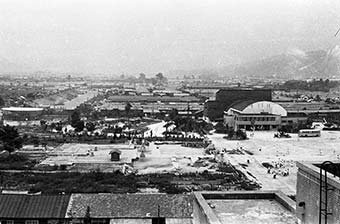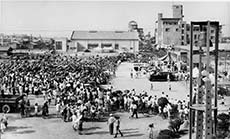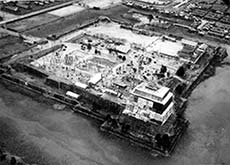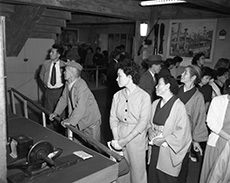Becoming a Lively Place - 1
In the city reconstruction plan that was decided in 1946, a park had been planned for the majority of western Moto-machi. Later, the Hiroshima Peace Memorial City Construction Law was issued and the Hiroshima Peace Memorial City Construction Plan was settled in 1952.
The southern portion of western Moto-machi became home to a variety of cultural and athletic facilities.

Children’s facilities in the park
On the right in this photograph, the public space can be seen in the fore with the Children’s Culture Center behind it. On the left is the site of Hiroshima Gokoku Shrine with the Children’s Library in the background.
August 5, 1953 Courtesy of Hiroshima Municipal Archives

Kids sketching in front of the Children’s Culture Center
The Children’s Culture Center was the first cultural facility to be built in Hiroshima City after the bombing. It opened on May 3, 1948.
1949 Taken by Yuichiro Sasaki Courtesy of Yugo Shioura
Progress towards Peace
The Third Peace Festival was held in 1949 in the public space in front of the Children’s Culture Center. Hiroshima City mayor, Shinzo Hamai, announced his Peace Declaration.
In July 1949, the Chuo Community Hall was built on the east side of the Hiroshima Chamber of Commerce and Industry, which currently sits along Aioi Avenue, and in September of the same year a single room became the A-bomb Reference Material Display Room. The predecessor of the current Peace Memorial Museum, it displayed damaged roofing tiles and materials related to the bombing.

The Third Peace Festival
The Hiroshima Peace Festival was held from 1947 to 1949 with a ceremony on August 6.
August 6, 1949 Collection of Chugoku Shimbun

A-bomb Reference Material Display Room
September 25, 1949
Collection of Chugoku Shimbun
Hiroshima Castle
Although the Hiroshima Castle Tower was lost to the A-bomb, it was rebuilt as one of the sites for the Hiroshima Restoration Exposition, appearing much as it had prior to the bombing.
The Hiroshima Castle Tower that had been a familiar sight to the people of Hiroshima once again took its place as the Moto-machi landmark, and it seemed to look out over the reconstruction efforts of the whole city.

Construction on the castle tower progresses
1957
Collection of Chugoku Shimbun

Hiroshima Restoration Exposition (Folk Exhibit)
The exposition was held over a 50-day period from April 1 to May 20, 1958. While intending to promote the restoration of Hiroshima, it also aimed to display the best of modern science, trade, and culture. A folk exhibit was set up in the castle tower, the third of three exposition sites, for introducing Hiroshima history and nature.
April 1958 Courtesy of Hiroshima Municipal Archives
